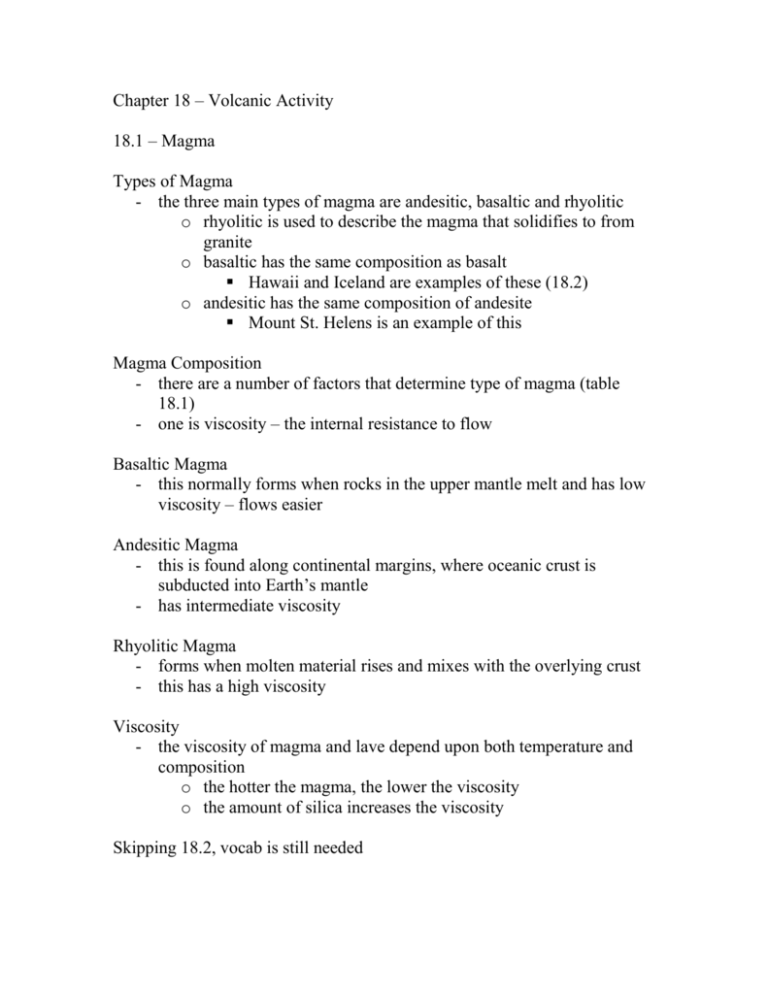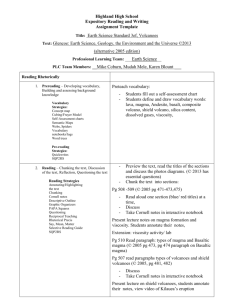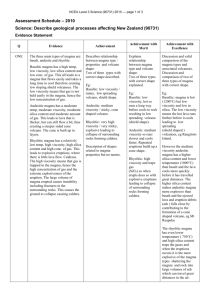Chapter 18 – Volcanic Activity
advertisement

Chapter 18 – Volcanic Activity 18.1 – Magma Types of Magma - the three main types of magma are andesitic, basaltic and rhyolitic o rhyolitic is used to describe the magma that solidifies to from granite o basaltic has the same composition as basalt Hawaii and Iceland are examples of these (18.2) o andesitic has the same composition of andesite Mount St. Helens is an example of this Magma Composition - there are a number of factors that determine type of magma (table 18.1) - one is viscosity – the internal resistance to flow Basaltic Magma - this normally forms when rocks in the upper mantle melt and has low viscosity – flows easier Andesitic Magma - this is found along continental margins, where oceanic crust is subducted into Earth’s mantle - has intermediate viscosity Rhyolitic Magma - forms when molten material rises and mixes with the overlying crust - this has a high viscosity Viscosity - the viscosity of magma and lave depend upon both temperature and composition o the hotter the magma, the lower the viscosity o the amount of silica increases the viscosity Skipping 18.2, vocab is still needed 18.3 – Volcanoes Anatomy of a Volcano - lava erupts through an opening called a vent o as the lave flows onto the surface it cools and hardens around the vent o over time the hardening lave can accumulate and form a volcano o at the top of the volcano a bowl shaped depression, called a crater, forms o large craters are called calderas o fig 18-11 shows a lake that formed in a caldera Types of Volcanoes - the appearance of a volcano depends on two factors o the type of material that forms the volcano o type of eruptions that occur Shield Volcanoes - this has a mountain with a broad, gently sloping side and a nearly circular base - they form when layer upon layer of basaltic lava accumulate during nonexplosive eruptions o Hawaii Cinder-Cone Volcanoes - this forms when material ejected high into the air falls back to Earth and piles up around the vent - these have steep sides and are generally small - these are more explosive then shield volcanoes Composite Volcanoes - these form when layers of volcanic fragments alternate with lava - these are much larger then cinder-cone volcanoes and can be very explosive - Mount St. Helens Size and Slope - fig 18-12 through 18-14 Volcanic Material - rock fragments thrown into the air during an eruption are called tephra o they are classified by size dust < 0.25 mm ash < 2.0 mm lapilli > 2.0 mm - largest can be the size of a car or small building Pyroclastic Flow - rapidly moving tephra and volcanic ash which rapidly moves down the volcano - can move at 200 km/h and temps can exceed 700 degrees Celsius Where do Volcanoes Occur? - most form at plate boundaries o 80% at convergent, 15% at divergent Convergent Volcanism - fig 18-16 - these volcanoes occur in 2 major belts o The Circum-Pacific Belt and Mediterranean Belt Divergent Volcanism - these form at rift zones - most occur under water along ocean ridges Hot Spots - these are volcanoes found far away from plate boundaries - Hawaii was formed by this







